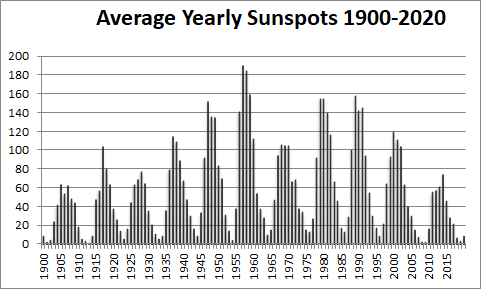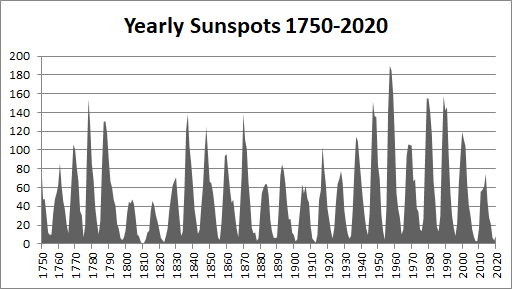2021 SUNSPOT PREDICTIONS
- Bill Hansen
- on Jun, 30, 2016
- No Comments.
NEWS BEFORE THE NEWS
SUNSPOTS
Sunspots have a lot to do with weather trends. They also indicate during their cyclical rise and peak restlessness, anxiety, tension, increased accidents, storminess and cooler weather, conflicts, wars, pandemics (72% of the time), and mass human/animal migrations. Low sunspot periods correspond with less human energy and production, epidemic diseases (28% of the time), and generally more peaceful world affairs. Sunspots generally reflect super lows in stock market prices around minimum numbers, and super highs prices around maximum numbers.
Sunspot Cycle 24 peaked in 2014 and is relatively weak with only 74.7 average sunspots monthly. The 2014 sunspot crest is slightly higher than the 1907 peak and closer in appearance to the 1883 and 1928 peak, all of which were extremely weak. It is doubtful, however, that we are entering a prolonged period of suppressed sunspots like the Maunder Minimum (the Little Ice Age) between 1645 and 1715, or the lesser deep freeze of the early 1800s centering around 1804 and 1816. During super low maximum periods solar energy is reduced (ultraviolet rays, solar wind, etc.) and weaker geomagnetic fields take place adding to bitterly cold seasons.

The Maunder Minimum and other super low sunspot periods can be explained astrologically. Over the past 4000 years super low maximums have correlated with nearly every conjunction and opposition aspect between Neptune and Pluto. This is likely due to the fact that the Neptune/Pluto orbital system is remarkably aligned with the solar equator. The equator of the Sun is a fundamental reference plane to which we could refer all planetary motion. Consecutive Neptune-Pluto conjunctions occur close to the same degree, which happens to be near the solar equator. The midpoint of the opposition between Neptune and Pluto likewise closely aligns with the solar equator. The last conjunction between Neptune and Pluto occurred January 29, 1892 at 880 01’ (280 Gemini 01’). The next square of 900 is August 11, 2063 at 850 23’ (250 Gemini 23’) another very cold time. The next opposition at 700 44’ (100 Gemini-Sagittarius 44’), and corresponding “little ice age,” takes place around April 22, 2139.
[The inclination of the solar equator to the ecliptic is 70 15’ and the longitude of the ascending node to the ecliptic in 1950 was 750 04’ (150 Gemini).]

Sextile and trine aspects between Neptune and Pluto correlate with very high sunspot peak periods, whereas lower sunspot peaks occur during the conjunction, square, and opposition. Sunspot minimums, on the other hand, appear to closely follow the Jupiter/Neptune conjunction, opposition, and certain trine and sextile cycles because their midpoint aligns with the solar equator. In fact, all the major solar (sunspot) periods are harmonic divisions of the Jupiter/Neptune cycle! There are literally 36 different planet combinations (and some of their midpoints) that resonate with solar cycles.
Although certain planetary cycles have corresponded with sunspot cycles in a remarkably close fashion, a few out-of-step periods appear in the record. The last time this occurred was between 1770 and 1800. Interestingly, this was a time when the Neptune/Pluto midpoint was conjunct the solar equator, Neptune was trine Pluto, and Uranus was square Neptune! This unusual array of important solar indicators apparently threw-off the normal patterns by a few years. The normal pattern returned once the unusual aspects dispersed.
Neptune and Pluto form a sextile (60-degree) aspect in 2028. This signals another spike in sunspot numbers and not a ‘deep freeze’ of relatively low sunspot maximums. The Neptune/Pluto midpoint will also be near the south node of the solar equator within a few years of this. These alignments may temporarily disrupt the normal pattern of planet and sunspot performance. Nevertheless, biological agitation resulting in increased tension, violence, migrations, and accidents – plus huge geomagnetic storms capable of disrupting communication channels and the power grid – are forecast for the sunspot peaks around 2028.
Recent Posts
- A Grand Time
- Financial Forecast 2025
- Temperature Trends 2024-25
- Precipitation Trends 2024-25
- Sunspots 2024-25
Categories
Pages
- Home
- Books
- Home
- Newsletters
- 2020 Triple Alignment
- Black Holes
- I Heard It Through the Grapevine
- Jupiter-Saturn Star Comments
- Jupiter/Pluto 2020: The Great Transition
- Jupiter/Saturn Conjunction 12/21/2020
- More Donald Trump Drama
- More Earthquakes in 2018-2023
- Progressive Policies and the Uranus/Pluto Cycle
- The Star of Impeachment
- Services
- Testimonials
- The Reshaping of America
- The United States Compatibility with President Trump
- Videos
- Your Astrologer
